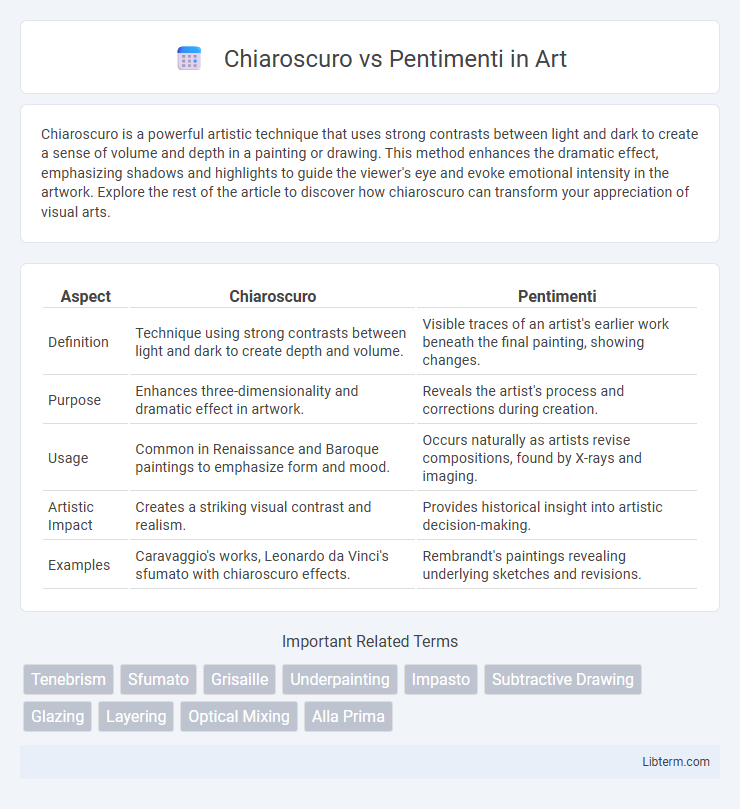Chiaroscuro is a powerful artistic technique that uses strong contrasts between light and dark to create a sense of volume and depth in a painting or drawing. This method enhances the dramatic effect, emphasizing shadows and highlights to guide the viewer's eye and evoke emotional intensity in the artwork. Explore the rest of the article to discover how chiaroscuro can transform your appreciation of visual arts.
Table of Comparison
| Aspect | Chiaroscuro | Pentimenti |
|---|---|---|
| Definition | Technique using strong contrasts between light and dark to create depth and volume. | Visible traces of an artist's earlier work beneath the final painting, showing changes. |
| Purpose | Enhances three-dimensionality and dramatic effect in artwork. | Reveals the artist's process and corrections during creation. |
| Usage | Common in Renaissance and Baroque paintings to emphasize form and mood. | Occurs naturally as artists revise compositions, found by X-rays and imaging. |
| Artistic Impact | Creates a striking visual contrast and realism. | Provides historical insight into artistic decision-making. |
| Examples | Caravaggio's works, Leonardo da Vinci's sfumato with chiaroscuro effects. | Rembrandt's paintings revealing underlying sketches and revisions. |
Understanding Chiaroscuro: Definition and Origins
Chiaroscuro is a technique in art that emphasizes the contrast between light and shadow to create the illusion of volume and depth, originating during the Renaissance period. This method was pioneered by artists like Leonardo da Vinci and Caravaggio, who used light and dark to enhance realism and emotional intensity in their paintings. Understanding chiaroscuro is essential for distinguishing it from pentimenti, which refers to visible changes or corrections in a painting revealing the artist's initial intentions.
What Is Pentimenti? Historical Context
Pentimenti refer to the visible traces of earlier painting alterations beneath the surface of a finished artwork, revealing an artist's process and changes in composition over time. Originating from the Italian word meaning "repentance," pentimenti became particularly significant during the Renaissance period when artists like Titian and Caravaggio revised their works to achieve desired effects. This historical context underscores pentimenti as valuable evidence in art conservation and authenticating masterpieces, differentiating them from chiaroscuro, which involves the play of light and shadow to create depth and volume.
Key Differences: Chiaroscuro vs Pentimenti
Chiaroscuro refers to the technique of using strong contrasts between light and dark to create the illusion of volume and depth in painting, emphasizing dramatic effect and three-dimensionality. Pentimenti denote visible alterations or corrections made by the artist during the painting process, revealing changes in composition or design beneath the final surface. The key difference lies in their artistic purpose: chiaroscuro is an intentional stylistic method for enhancing visual impact, while pentimenti are unintended traces of the creative process that provide insight into the artist's adjustments.
The Role of Light and Shadow in Chiaroscuro
Chiaroscuro employs dramatic contrasts between light and shadow to create a sense of depth and volume, enhancing the three-dimensionality of subjects in artwork. This technique manipulates illumination to highlight focal points, directing viewers' attention and evoking emotional intensity. Unlike pentimenti, which reveal an artist's alterations beneath the surface, chiaroscuro intentionally utilizes controlled lighting to shape composition and narrative impact.
Pentimenti: Evidence of Artistic Process
Pentimenti reveal an artist's evolving creative decisions through visible changes or corrections beneath the final paint layer, providing valuable insights into their artistic process and thought development. Unlike chiaroscuro, which emphasizes strong contrasts of light and shadow to create depth and volume, pentimenti expose the underlying revisions that reflect the dynamic nature of composition and technique. These alterations serve as critical evidence for art historians and conservators in understanding the artwork's history and the artist's original intentions.
Techniques Used in Chiaroscuro Painting
Chiaroscuro painting employs the technique of using strong contrasts between light and dark to create a sense of volume and three-dimensionality, often achieved through gradual shading and precise light placement. Artists use layering and glazing methods to deepen shadows while highlighting focal points, enhancing the dramatic effect. This technique contrasts with pentimenti, which reveals an artist's changes through underlying sketches rather than focusing on light manipulation.
Famous Artists Known for Chiaroscuro
Caravaggio and Rembrandt are renowned for their masterful use of chiaroscuro, a technique emphasizing strong contrasts between light and dark to create depth and volume in paintings. Unlike chiaroscuro, pentimenti are alterations or changes visible in a painting's underlayers, revealing the artist's revisions during the creative process. Famous artists linked to chiaroscuro often utilized this method to heighten emotional intensity and realism in their works, distinguishing their art from those simply documented with pentimenti.
Pentimenti in Renaissance and Baroque Art
Pentimenti, visible traces of earlier compositional changes, reveal the evolving creative process in Renaissance and Baroque art, highlighting artists' adjustments to figures, poses, or compositions. These revisions were often uncovered through X-rays and infrared reflectography, offering insight into the artist's intentions and techniques during these periods. In contrast, chiaroscuro emphasizes dramatic light and shadow to create volume and depth, while pentimenti provide a historical narrative of artistic experimentation and refinement.
Interplay of Technique: When Chiaroscuro and Pentimenti Overlap
The interplay of chiaroscuro and pentimenti highlights the dynamic process of artistic creation, where dramatic contrasts of light and shadow reveal underlying compositional changes. Chiaroscuro's manipulation of light intensity enhances the visibility of pentimenti--traces of earlier artistic decisions--allowing viewers to witness the evolution of the image beneath the surface. This overlap not only enriches the visual depth but also offers insight into the painter's iterative approach and shifting narrative intent.
Chiaroscuro and Pentimenti in Contemporary Art Analysis
Chiaroscuro in contemporary art analysis highlights the dramatic interplay of light and shadow to create depth, emphasizing emotional intensity and visual contrast. Pentimenti reveal an artist's evolving process, exposing underlying changes and revisions that add layers of meaning and authenticity to the work. Both techniques offer critical insights into the creative development and narrative complexity within modern visual compositions.
Chiaroscuro Infographic

 libterm.com
libterm.com